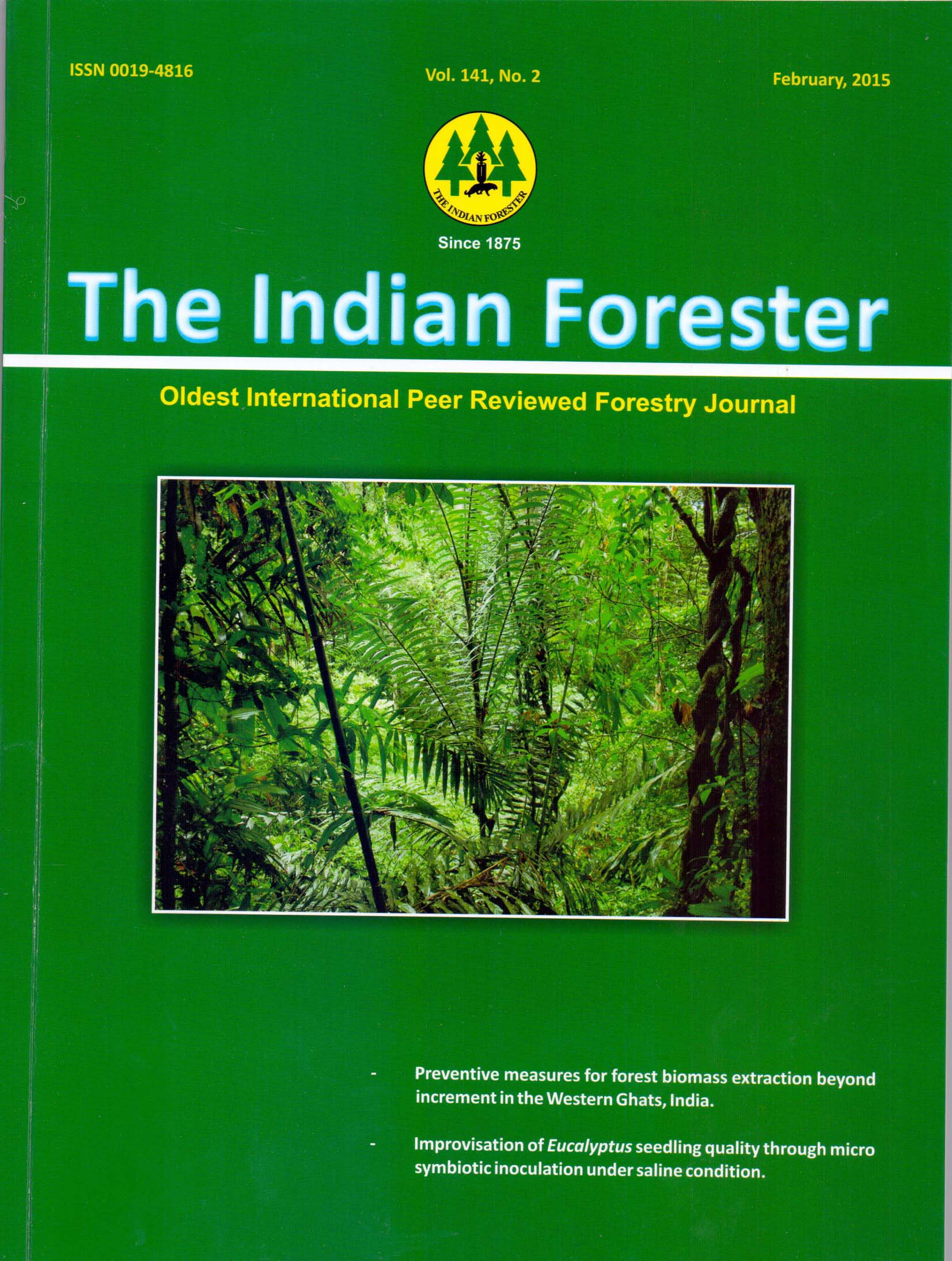Biomass Expansion Factor and Root-to-Shoot Ratio of Some Tree Species of Punjab, India
DOI:
https://doi.org/10.36808/if/2015/v141i2/60650Keywords:
Biomass Expansion Factor (BEF), Root-to-Shoot Ratio (R), Eucalyptus Hybrid, Dalbergia Sissoo, Acacia Catechu, Poplar Deltoids, Punjab, India.Abstract
The present study was conducted in Eucalyptus hybrid (safeda), Dalbergia sissoo (shisham/tahli), Acacia catechu (khair), Populus deltoides (poplar) plantations of different ages at different sites in Punjab. Biomass was calculated on the basis of complete tree harvesting method (stratified mean tree technique method). Biomass Expansion Factors (BEFs) and root-to-shoot ratio (R) of 4 tree species were calculated. Sample trees of Eucalyptus hybrid were of 18, 28 and 30 years of age. BEFs for 3 age series were as 1.39 for 18 years, 1.23 for 28 years and 1.31 for 30 years. Similarly R values assessed were 0.19, 0.15 and 0.17 at 18, 28 and 30 years, respectively. Sample trees of Dalbergia sissoo had age series of 25, 27, 29 and 33 years. BEF assessed for 4 age series were 1.96, 1.64, 1.44 and 1.62 and R values assessed as 0.36, 0.41, 0.26 and 0.37 respectively. Similarly Acacia catechu trees had age series of 20, 22, 23, 24, 28, and 32 years. BEF calculated for Acacia catechu series were1.51, 1.66, 1.49, 1.50, 1.63 and 1.98, respectively and R values as 0.28, 0.22, 0.20, 0.23, 0.26 and 0.22, respectively. Populus deltoides was studied in the farmer's field. The age of plantation was 7 years, BEF and R value for P. deltoides were assessed as 1.47 and 0.12, respectively.References
Art H.W. and Marks P.L. (1971). A summary table of biomass and net primary production in forest ecosystems of the world. In: Forest Biomass Studies (ed. Young H.E.). College of Life Sciences and Agricultural Experiment Station. Univ. of Maine, USA.
Bartelink H.H. (1997). Allometric relationships for biomass and leaf area of beech (Fagus sylvatica L.). Ann. For. Sci., 54:39-50.
Brown S., Gillespie A.J.R. and Lugo A.E. (1989). Biomass estimation methods for tropical forests with applications to forest inventory data. For. Sci., 35:881-902.
Chhabra A., Palria S. and Dadhwal V.K. (2002). Growing stock based forest biomass estimate for India. Biomass and Bioenergy, 22(3):187194.
FAO (1997). State of the world's forests. Food and Agricultural Organization of the United Nations; 1997, 200.
Hall C.A.S and Uhlig J. (1991). Refining estimates of carbon release from tropical land use change. Canadian Journal of Forestry Research, 21:118-131.
IPCC (2006). Intergovernmental Panel on Climate Change. Guidelines for National Greenhouse Gas Inventories [http://www.ipcc.ch].
Kilbride C.M., Byrne K.A., Gardiner J.J. (1999). Carbon sequestration and Irish forests. COFORD, Dublin.
Lehtonen A., Makipaa R., Heikkinen J., Sievanen R. and Liski J. (2004). Biomass expansion factors (BEFs) for Scots pine, Norway spruce and birch according to stand age for boreal forests. For. Ecol. & Manage., 188(1-3)):211-224.
Lehtonen A., Cienciala E., Tatarinov F., Makipaa R. ( 2007). Uncertainty estimation of biomass expansion factors for Norway spruce in the Czech Republic. Ann. For. Sci., 64, 133-140.
Levy P.E., Hale S.E. and Nicoll B.C. (2004). Biomass expansion factors and root: shoot ratios for coniferous tree species in Great Britain. Forestry, 77(5):421-430.
Liski J., Perruchoud D. and Karjalainen T. (2002). Increasing carbon stocks in the forest soils of Western Europe. For. Ecol. & Manage., 169:163-179.
Milne R., Brown T.A.W., Murray T.D. (1998). The effect of geographical variation of planting rate on the uptake of carbon by new forests of Great Britain. Forestry, 71:297-309
Negi J.D.S. (1984). Biological productivity and cycling of nutrients in managed and man-made ecosystems. Ph. D. Thesis, Garhwal Univ. Srinagar Garhwal, UP. pp 161.
Sehgal J.L., Mandal D.K. and Vadivelu S. (1990). Agro-Ecological Regions of India. Technical Bulletin. NBSS Publ. 24. National Bureau of Soil Survey and Land Use Planning (ICAR) Nagpur, India. 73pp.
Sanquetta C.R., Corte A.P. and Silva F.D. (2011). Biomass expansion factor and root-to-shoot ratio for Pinus in Brazil. Carbon Balance and Management, 6:6.
Schroeder P., Brown S., Mo J., Birdsey R. and Cieszewski C. (1997). Biomass estimation for temperate broadleaf forests of the United States using inventory data. For. Sci., 43(3):424-434.
Shoene D. (2002) Terminology in assessing and reporting forest carbon change. In: Second expert meeting on harmonizing forest-related definitions for use by various stakeholders. FAO, Rome.
Soares P. and Tome M. (2004): Analysis of the effectiveness of biomass expansion factors to estimate stand biomass. In: Modeling Forest Production. (H. Hasenauer and A. Makela eds.), Proc. Conf. Vienna, 19-21 April (Department of Forest and Soil Sciences, BOKU University of Natural Resources and Applied Life Sciences, Vienna. pp.368-374.
Ter-Mikaelian M.T. and Korzukhin M.D. (1997). Biomass equations for sixty-five North American tree species. For. Ecol. & Manage., 97:1-24.
Tobin B. and Nieuwenhuis M. (2007). Biomass expansion factors for Sitka spruce (Picea sitchensis (Bong) Carr.) in Ireland. Eur. J. For. Res., 126, 189-196.
Downloads
Downloads
Published
How to Cite
Issue
Section
License
Unless otherwise stated, copyright or similar rights in all materials presented on the site, including graphical images, are owned by Indian Forester.





